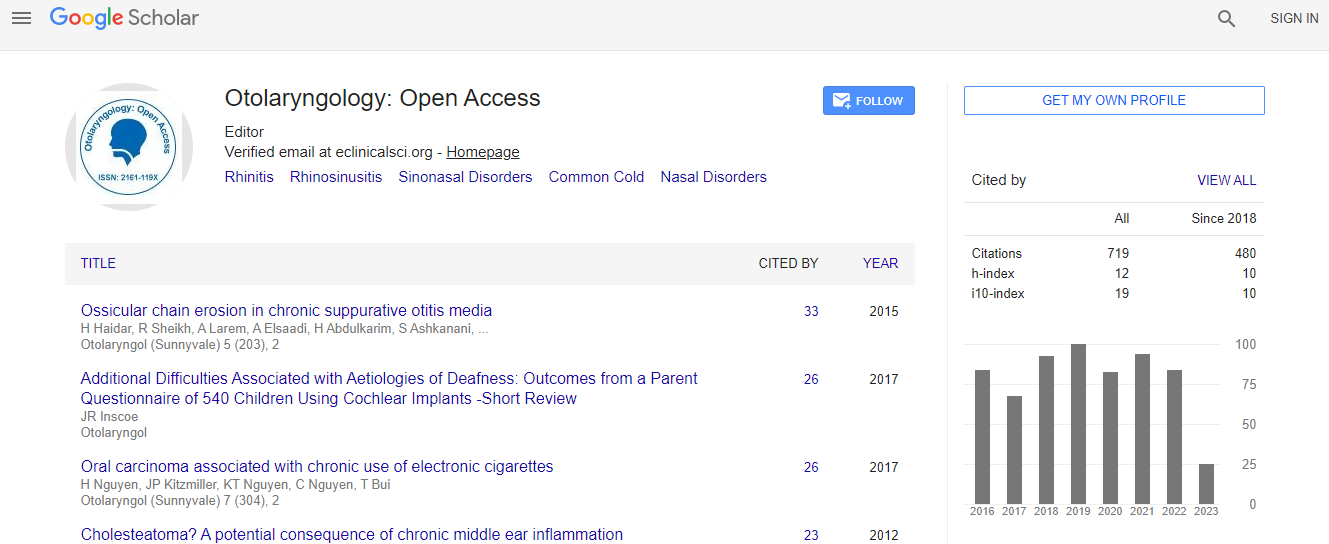Our Group organises 3000+ Global Conferenceseries Events every year across USA, Europe & Asia with support from 1000 more scientific Societies and Publishes 700+ Open Access Journals which contains over 50000 eminent personalities, reputed scientists as editorial board members.
Open Access Journals gaining more Readers and Citations
700 Journals and 15,000,000 Readers Each Journal is getting 25,000+ Readers
Google Scholar citation report
Citations : 925
Otolaryngology: Open Access received 925 citations as per Google Scholar report
Otolaryngology: Open Access peer review process verified at publons
Indexed In
- Index Copernicus
- Google Scholar
- Sherpa Romeo
- Open J Gate
- Genamics JournalSeek
- RefSeek
- Hamdard University
- EBSCO A-Z
- OCLC- WorldCat
- Publons
- Geneva Foundation for Medical Education and Research
- ICMJE
Useful Links
Recommended Journals
Related Subjects
Share This Page
Understanding temporal bone Aqueducts in cochlear implant surgery
International Conference on Aesthetic Medicine and ENT
Padma Shri Dr. Jitender Mohan Hans
Dr. Hans Centre for ENT & Cochlear Implant, India
Keynote: Otolaryngology
Abstract
Aim: To understand and assess the presence of abnormal cochlear aqueduct and vestibular aqueduct and their presentation during cochlear implant surgery Methods: The study involved 100 cases of a large cochlear aqueduct and 50 cases of large vestibular aqueduct which were identified on radiological assessment prior to surgery. The cases were operated by the same surgeon and by VERIA technique. The large cochlear aqueducts presented with CSF gushers after cochleostomy and the large vestibular aqueducts presented as pulsatile leak of perilymph. The cochleostomy in large cochlear aqueducts and the large vestibular aqueducts cases were sealed at the time of the CSF leak by the three handed technique in VERIA technique with a dumbbell shaped tissue seal or by using the specially designed electrode array. Results: Large cochlear aqueducts presented with CSF gushers on cochleostomy which required a better preparedness during surgery to seal the cochleostomy at the time of the gusher to obtain a complete seal and the large vestibular aqueducts presented as a mild pulsatile leak of perilymph which was self-limiting and was easily sealed using tissue. All cases were sealed well at the cochleostomy and did not require any lumbar drain. Conclusion: Better access provided by VERIA technique provides the surgeon a complete access to the cochlea which enables a three handed control of the gushers for better sealing of cochleostomy. Knowing the aqueducts radiologically prior to surgery is a must for every cochlear implant surgeon.Biography
Padma Shri awardee Prof. (Dr) J M Hans, is a topper and medalist from PGI Chandigarh. Dr. Hans has done pioneering work in the field of cochlear implant surgery and has done more than 1500 cochlear implants in his centers around the country and also in SAARC countries. He is the Founder Member of the Cochlear Implant Group of India. He is currently Chairman& Director of Dr. Hans Centre for ENT & Cochlear Implant and Chairman of Dept of ENT & Cochlear Implant, Venkateshwar Hospital, Dwarka, New Delhi. He is Honorary Consultant to Ex-Prime Minister of India. Dr. Hans is Government Member to the Ali Yajur Jung National Institute for Deafness, Mumbai. The Government appointed him as Executive Member of the All India Institute of Speech and Hearing, Mysore. He is appointed Member to the National Program on Prevention and Control on Deafness (NPPCD) and Advisor to UPSC and WHO. He pioneered the minimally invasive technique for Cochlear Implantation in India. He is also advisor Cochlear Implant Surgeon to Pingalwara Trust in Amritsar. He is visiting cochlear implant surgeon to the Medical Colleges of Chattisgarh, Andhra Pradesh and Madhya Pradesh, PGI Chandigarh etc., to perform CI surgery on deaf and dumb children. Member of ADIP, Committee of Cochlear Implant, Govt. of India and Executive Council AIISH Mysore.
Email: jmhans1@gmail.com

 Spanish
Spanish  Chinese
Chinese  Russian
Russian  German
German  French
French  Japanese
Japanese  Portuguese
Portuguese  Hindi
Hindi 
